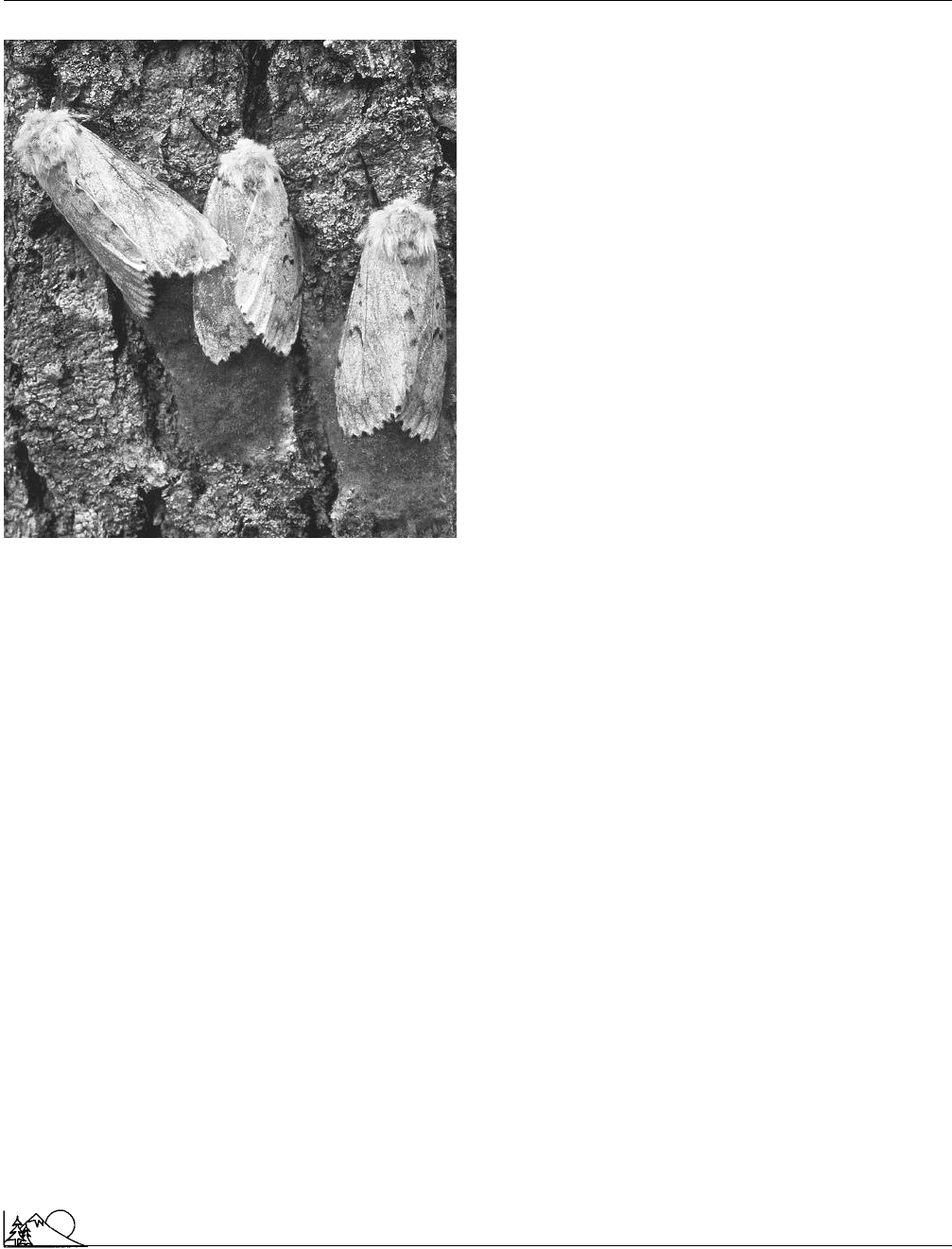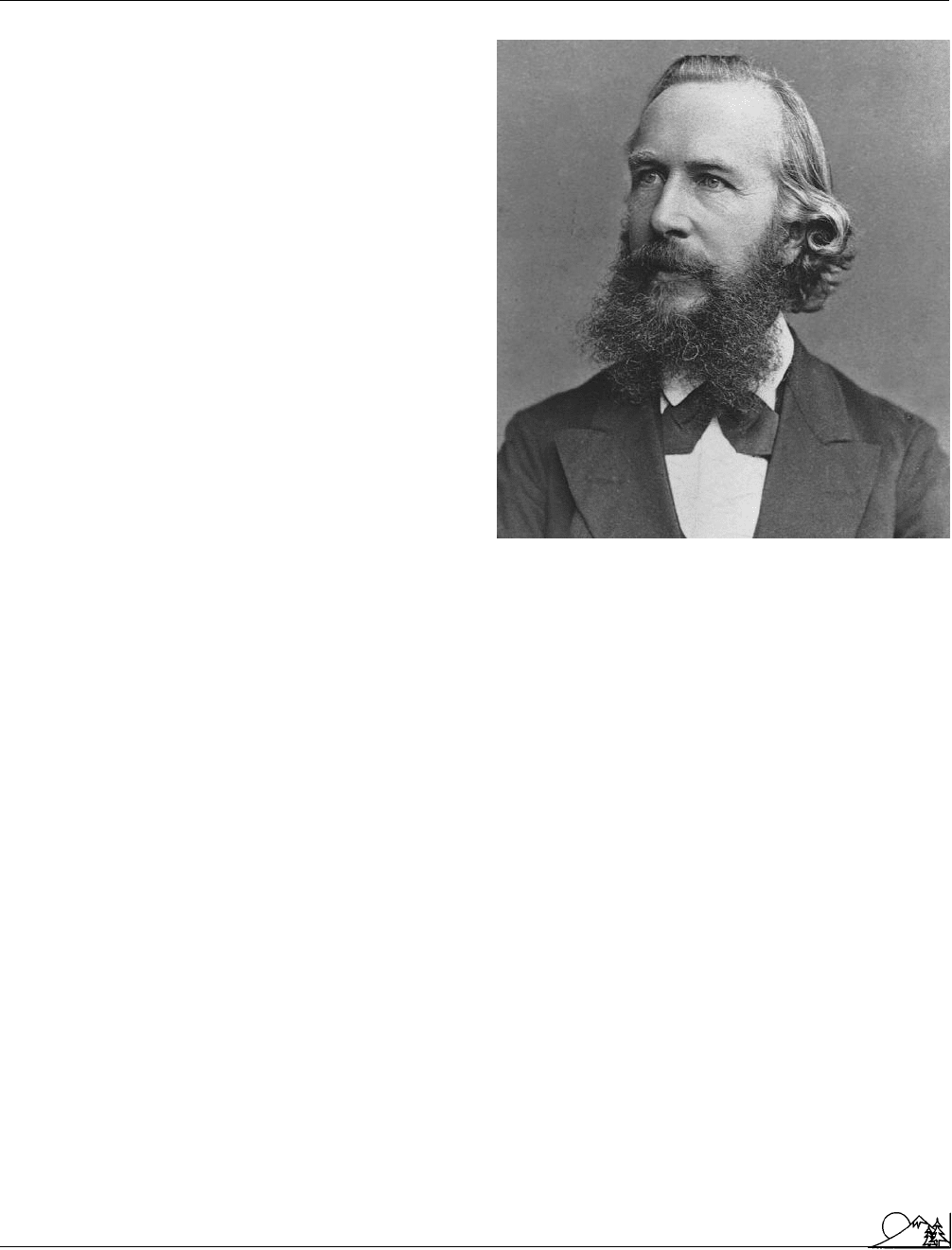Environmental Encyclopedia
Подождите немного. Документ загружается.


Environmental Encyclopedia 3
Gypsy moth
Gypsy moth females laying eggs. (Photograph by
Michael Gadumski. Photo Researchers Inc. Reproduced
by permission.)
tion over the next 20 years. The destructive abilities of the
gypsy moth became readily apparent to area residents, who
watched large sections of forest be destroyed by the larvae.
From the initial infestation in Massachusetts, the gypsy moth
spread throughout the northeastern United States and south-
eastern Canada. As of 2001, the following states were quar-
antined: Connecticut, Delaware, Maryland, Michigan, New
Hampshire, New Jersey, New York, Pennsylvania, Rhode
Island, and Vermont. More that two-thirds of Virginia is
quarantined, as well as sections of Ohio, Indiana, Maine,
North Carolina, Wisconsin, and Wyoming. The U. S. De-
partment of Agriculture reports that virtually all areas that
have experienced an invasion of gypsy moths continue to
have extremely high levels of infestation.
Gypsy moths have a voracious appetite for leaves, and
the primary environmental problem caused by them is the
destruction of huge areas of forest. Gypsy moth caterpillars
687
defoliate a number of
species
of broadleaf trees including
birches, larch, and aspen, but prefer the leaves of several
species of oaks, though they have also been found to eat
some evergreen needles. One caterpillar can consume up to
one square foot of leaves per day. In 2001, 84.9 million acres
(34.4 million ha) had been defoliated by these insects. The
sheer number of gypsy moth caterpillars produced in one
generation can create other problems as well. Some areas
become so heavily infested that the insects have covered
houses and yards, causing psychological difficulties as well
as physical.
There are few natural predators of the gypsy moth in
North America, and none that can keep its population under
control. Attempts have been made since the 1940s to control
the insect with pesticides, including DDT, but these efforts
have usually resulted in further contaminating of the
envi-
ronment
without controlling the moths or their caterpillars.
Numerous attempts have also been made to introduce species
from outside the region to combat it, and almost 100 differ-
ent natural enemies of the gypsy moth have been introduced
into the northeast United States. Most of these have met,
at best, with limited success. Recent progress has been made
in experiments with a Japanese fungus that attacks and kills
the gypsy moth. The fungus enters the body of the caterpillar
through its pores and begins to destroy the insect from the
inside out. It is apparently non-lethal to all other species in
the infested areas, and its use has met with limited success
in parts of Rhode Island and upstate New York. It remains
unknown however, whether it will control the gypsy moth,
or at least stem the dramatic population increases and severe
infestations.
[Eugene C. Beckham]
R
ESOURCES
P
ERIODICALS
Pond, D., and W. Boyd. “Gypsy on the Move.” American Forests 98 (March–
April 1992): 21–25.
O
THER
Gypsy Moth in North America. September 15, 1998 [cited May 2002].
<http://www.fs.fed.us/ne/morgantown/4557/gmoth>.
Gypsy Moth in Virginia. April 10, 2001 [cited May 2002]. <http://www.gyp-
symoth.ento.vt.edu/vagm/index.html>.
U.S. Department of Agriculture. “Plant Protection and Quarantine: Gypsy
Moth Quarantine.” Animal and Plant Health Inspection Service. June 15,
2001 [cited May 2002]. <http://www.aphis.usda.gov/ppq/maps/gyp-
moth.pdf>.
This Page Intentionally Left Blank

H
Arie Jan Haagen-Smit (1900 – 1977)
Dutch atmospheric chemist
The discoverer of the causes of
photochemical smog
,
Haagen-Smit was one of the founders of atmospheric chem-
istry, but first made significant contributions to the chemistry
of essential oils. Haagen-Smit was born in Utrecht, Holland,
in 1900, and graduated from the University of Utrecht. He
became head assistant in organic chemistry there and later,
served as a lecturer until 1936. He came to the United States
as a lecturer in biological chemistry at Harvard, then became
associate professor at the California Institute of Technology
in Pasadena. He retired as Professor of Biochemistry in
1971, having served as executive officer of the department
of biochemistry and director of the plant
environment
labo-
ratory. Haagen-Smit also contributed to the development of
techniques for decreasing
nitrogen
oxide formation during
combustion
in electric
power plants
and autos, and to
studies of damage to plants by
air pollution
.
While early workers on the
haze
and eye irritation
that developed in Los Angeles, California, tried to treat it
as identical with the
smog
(
smoke
+ fog) then prevalent
in London, England, Haagen-Smit knew at once it was
different. In his reading, Haagen-Smit had encountered a
1930s Swiss patent on a process for introducing random
oxygen functions into
hydrocarbons
by mixing the hydro-
carbons with nitrogen dioxide and exposing the mixture to
ultraviolet light. He thought this mixture would smell much
more like a smoggy day in Los Angeles than would some sort
of mixture containing
sulfur dioxide
, a major component of
London smog. He followed the procedure and found his
supposition was correct. Simple analysis showed the mixture
now contained
ozone
, organic peroxides, and several other
compounds. These findings showed that the sources of the
problems of Los Angeles were
petroleum
refineries,
petro-
chemical
industries, and ubiquitous
automobile
exhaust.
Haagen-Smit was immediately attacked by critics, who
set up laboratories and developed instruments to prove him
689
wrong. Instead the research proved him right, except in
minor details.
Haagen-Smit had a long and distinguished career. In
addition to his work on the chemistry of essential flower
oils and famous findings on smog, he also contributed to
the chemistry of plant hormones and plant alkaloids and the
chemistry of
microorganisms
. He was a founding editor
of the International Journal of Air Pollution, now known as
Atmospheric Environment, one of the leading air
pollution
research journals. Though he found the work uncongenial,
he stayed with it for the first year, then retired to the editorial
board, where he served until 1976.
Once it was obvious that he had correctly identified
the cause of the Los Angeles smog, he was showered with
honors. These included membership in the National Acad-
emy of Science, receipt of the Los Angeles County Clean Air
Award, the Chambers Award of the
Air Pollution Control
Association (now the
Air and Waste Management Associ-
ation
), the Hodgkins Medal of the Smithsonian Institution,
and the National Medal of Science. In his native Netherlands
he was made a Laureate of Labor by the Netherlands Chemi-
cal Society, and Knight of the Order of Orange Nassau.
[James P. Lodge Jr.]
R
ESOURCES
P
ERIODICALS
Lodge, J. P. “Obituary: A. J. Haagen-Smit.” Nature 267 (1977): 565–566.
Habitat
Refers to the type of
environment
in which an organism
or
species
occurs, as defined by its physical properties (e.g.,
rainfall, temperature, topographic position,
soil texture
,
soil
moisture) and its chemical properties (e.g., soil acidity, con-
centrations of nutrients and
toxins
, oxidation reduction sta-
tus). Some authors include broad biological characteristics in
their definitions, for instance forest versus
prairie
habitats,

Environmental Encyclopedia 3
Habitat conservation plans
referring to the different types of environments occupied by
trees and grasses. Within a given habitat there may be differ-
ent micro-habitats, for example the hummocks and hollows
on bogs or the different soil horizons in forests.
Habitat conservation plans
Protection of the earth’s
flora
and
fauna
, the myriad of
plants and animals that inhabit our planet, is totally depen-
dent upon preserving their habitats. This is because a
habi-
tat
, or natural
environment
for a specific variety of plant
or animal, provides everything necessary for sustaining life
for that
species
. Habitat
conservation
is part of a larger
picture involving interdependency between all living things.
Human life has been sustained since its dawning through
the utilization of both plants and animals for food, clothing,
shelter and medicines. It follows then that the destruction
of any specie’s environment, which will result in the eventual
destruction of the species itself, adversely affects us all.
Habitat destruction occurs for a number of reasons.
Human industry has usually resulted in
pollution
that has
often destroyed the balance of natural elements in
soil
, water
and air that are necessary to life. The need for forest products
such as lumber has threatened woodlands in more ways than
one. A lumbering practice called
clear-cutting
, in addition
to over-harvesting a forest, leaves behind barren ground that
results in
erosion
and threatens species dependent on the
vegetation that grows on the forest floor. This wearing away
of soil often results in negative changes to nearby streams
and thus the water supply to multitudes of living things.
The introduction of non-native species into an area can also
threaten a habitat, as plants and animals with no natural
enemies may thrive abnormally. This in turn will throw
off the delicate balance and natural biological controls on
population growth
that each environment provides for its
inhabitants.
As the understanding of these facts became more wide-
spread, the demand for habitat conservation throughout the
world increased. In the United States, in 1973, Congress
passed the
Endangered Species Act
to protect both at risk
species and their environments. In order to control activities
by private and non-federal government landowners that
might disturb habitats, the Act included a section outlining
Habitat Conservation Plans (HCPs).
These HCPs were not implemented without a good
deal of controversy. Some environmentalists were critical of
the plans, believing that they failed to actually preserve the
habitats and species they were designed to protect. Both
conservationists and landowners and industrialists argued
690
that these HCPs’ were based upon faulty science and invalid
and insufficient data. Impartial reviews did indicate that
there were flaws. One cited weakness was that a species
could theoretically be added to the endangered list but have
no modification made in the plan to protect that species’
living-space.
It is clearly a measure of this controversy that in the
law’s first twenty years, only fourteen such plans were devel-
oped and approved nationwide. During the administration
of President Bill Clinton, the federal government revised
policies to encourage more numerous and more effective
HCP applications. A more responsive to change “No sur-
prises" policy helped encourage participation in habitat con-
servation plans.
This policy recognizes that
natural resources
change
and environments require continual monitoring and alter-
ations in plans, that those trying to balance environments
can do so with
adaptive management
. Such alterations
encouraged participation in HCPs, and by 1997, more than
200 plans covering nine million acres of land had been
approved. As of April of 2002, the United States
Fish and
Wildlife Service
notes that nearly double that number, 379
plans covering nearly 30 million acres and protecting more
than 200 endangered and threatened species have now been
approved.
One positive example of the possibilities created by
such plans is the work of the Plum Creek Timber Company,
a nationwide timberland company whose corporate offices
are located in Seattle, Washington. Self-described as “the
second largest private timberland owner in the United States,
with 7.8 million acres located in the northwestern, southern
and northeastern regions of the country”, the company lists
many initiatives it has undertaken to preserve the environ-
ments under its charge. In the early 1990’s, Plum Creek
Timber Company developed a plan to provide a ladder-like
framework in Coquille River tributaries in Oregon to aid
fish in reaching upper areas blocked for many years by a
culvert. Spawning surveys completed the next year showed
that coho
salmon
and steelhead trout, for the first time in
forty years, were present above the culvert.
HCPs were created to focus attention on the problem
of declining
wildlife
on land not owned and protected by
the federal government and to attempt to maintain the
bio-
diversity
so necessary for all life. This goal would ideally
assure that land is developed in such a way that it serves
both the needs of the landowner and of threatened wildlife.
However, in reality, it is not always possible to achieve
such a goal. Often the more appropriate aim, if habitat
conservation is to be successful, will be total protection of
a wildlife environment even at the price of banning all devel-
opment.
[Joan M. Schonbeck]

Environmental Encyclopedia 3
Habitat fragmentation
R
ESOURCES
B
OOKS
Gilbert Oliver L., and Penny Anderson. Habitat Creation and Repair.New
York: Oxford University Press, 1998.
Walters, C. Adaptive Management of Renewable Resources.New York: Mac-
Millan, 1986.
P
ERIODICALS
Mann, C., and M. Plummer. “Qualified Thumbs Up for Habitat Plan
Science.” Science 278, no. 5346 (December 19, 1997): 2052.
O
RGANIZATIONS
Fish and Wildlife Reference Service, 54300 Grosvenor Lane, Suite 110,
Bethesda, MD USA 20814 (301) 492-6403, Toll Free: (800) 582-3421,
Email: fw9fareferenceservice@fws.gov, <http://www.lib.iastate.edu/
collections/db/usfwrs.html>
National Wildlife Federation, 111000 Wildlife Center Drive, Reston, VA
USA 20190 (703)438-6000, Toll Free: (800) 822-9919, Email:
info@nwf.org, <http://www.nwf.org>
Habitat fragmentation
The
habitat
of a living organism, plant, animal, or microbe,
is a place, or a set of environmental conditions, where the
organism lives. Net loss of habitat obviously has serious
implications for the survival and well-being of dependent
organisms, but the nature of remaining habitat is also very
important. One factor affecting the quality of surviving habi-
tat is the size of remaining pieces. Larger areas tend to be
more desirable for most
species
. Various influences, often
a result of human activity, cause habitat to be divided into
smaller and smaller, widely separated pieces. This process of
habitat fragmentation has profound implications for species
living there.
Each patch created when larger habitat areas are frag-
mented results in more edge area where patches interface
with the surrounding
environment
. These smaller patches
with a relatively large ratio of edge to interior area have
some unique characteristics. They are often distinguished
by increased predation when predators are able to hunt or
forage along this edge more easily. The decline of songbirds
throughout the United States is due in part to the increase
of the brown-headed cowbird competing with other birds
along habitat edges. The cowbird acts as a parasite by laying
its eggs in other birds’ nests and leaving them for other
birds to hatch and raise. After hatching, the young cowbirds
compete with the smaller birds of the nest, almost always
killing them.
In the smaller patches formed from fragmentation,
habitat is less protected from adverse environmental events,
and a single storm may destroy the entire area. A disease
outbreak may eliminate the entire population. When the
number of breeding adults becomes very low, some species
can no longer reproduce successfully.
691
Some songbirds found in the United States are declin-
ing in number as their habitat shrinks or disappears. When
they migrate south in the winter they find that habitat is
more scarce and fragmented. When they return from the
tropics in the spring, they discover that the nesting territory
that they used the previous year has disappeared.
Species dispersal is decreased as organisms must
travel farther to go from one habitat area to another,
increasing their exposure to predation and possibly harmful
environmental conditions. Populations become increasingly
insular as they become separated from related populations,
losing the genetic benefits of a larger interbreeding popu-
lation.
Road building often divides habitat areas, seriously
disrupting
migration
of some mammals and herptiles
(
frogs
, snakes, and turtles). Large swaths of land used by
modern freeways are particularly effective in this regard. In
earlier times, railroads built across the Great Plains to con-
nect the west coast of the United States with states east of
the Mississippi, divided
bison
habitat and hampered their
migration from one grazing area to another. This was one
of the factors that led to their near
extinction
.
Habitat fragmentation, usually a result of human activ-
ity, is found in all major habitat types around the world.
Rain forests,
wetlands
,
grasslands
, and hardwood and
conifer forests are all subject to various degrees of fragmenta-
tion. Globally, rain forests are currently by far the most
seriously impacted
ecosystem
. Because they contain 50%
or more of the world’s species, the resulting number of
species extinctions is particularly disturbing. It is estimated
that 25% of the world’s rainforests disappeared during the
twentieth century, and another 25% were seriously frag-
mented and degraded. In the last two centuries, nearly all
of the
prairie
grassland once found in the United States has
disappeared. Remaining remnants occur in small, scattered,
isolated patches. This has resulted in the extinction or near
extinction of many plant and animal species.
Ability to survive habitat fragmentation and other en-
vironmental changes varies greatly among species. Most find
the stress overwhelming and simply disappear. A few of the
common species that have been very successful in adapting
to changing conditions include animals such as the opossum,
raccoon, gray squirrel, and European starling. Plant examples
include dandelions, crab grass, creeping Charlie, and many
other weed species. The wetland invader,
purple loos-
estrife
, originally imported from Europe to the United
States, is rapidly spreading into disrupted habitat previously
occupied by native emergent aquatic vegetation such as reeds
and cattails. Animal species that once found a comfortable
home in cattail stands must move on.
[Douglas C. Pratt Ph.D.]

Environmental Encyclopedia 3
Ernst Heinrich Philipp August Haeckel
R
ESOURCES
B
OOKS
Cunningham, W. P., and Cunningham, M. A. Principals of Environmental
Science: Inquiry and Applications. McGraw-Hill, 2002.
Ernst Heinrich Philipp August Haeckel
(1834 – 1919)
German naturalist, scientist, biologist, philosopher, and
professor
Ernst Haeckel was born in Potsdam, Germany. As a young
boy he was interested in
nature
, particularly botany, and
kept a private herbarium, where he noticed that plants varied
more than the conventional teachings of his day advocated.
Despite these natural interests, he studied medicine—at his
father’s insistence—at Wu
¨
rzburg, Vienna, and Berlin be-
tween 1852 and 1858. After receiving his license he practiced
medicine for a few years, but his desire to study pure science
won over, and he enrolled at the University of Jena to study
zoology. Following completion of his dissertation, he served
as professor of zoology at the university from 1862 to 1909.
The remainder of his adult life was devoted to science.
Haeckel was considered a liberal non-conformist of
his day. He was a staunch supporter of Charles Darwin, one
of his contemporaries. Haeckel was a prolific researcher and
writer. He was the first scientist to draw a “family tree” of
animal life, depicting the proposed relationships between
various animal groups. Many of his original drawings are
still used in current textbooks. One of his books, The Riddle
of the Universe (1899), exposited many of his theories on
evolution
. Prominent among these was his theory of recapit-
ulation, which explained his views on evolutionary vestiges
in related animals. This theory, known as the Biogenic Law,
stated that “ontogeny recapitulates phylogeny"—the devel-
opment of the individual (ontogeny) repeats the history of
the race (phylogeny). In other words, he argued that when an
embryo develops, it passes through the various evolutionary
stages that reflect its evolutionary ancestry. Although this
theory was widely prevalent in biology for many years, scien-
tists today consider it inaccurate or only partially correct.
Some even argue that Haeckel falsified his diagrams to prove
his theory.
In
environmental science
, Haeckel is perhaps best
known for coining the term
ecology
in 1869, which he
defined as “the body of knowledge concerning the economy
of nature—the investigation of the total relationship of the
animal both to its organic and its inorganic
environment
including, above all, its friendly and inimical relations with
those animals and plants with which it directly or indirectly
comes into contact—in a word, ecology is the study of all
692
Ernst Haeckel. (Corbis-Bettmann. Reproduced by per-
mission.)
those complex interrelations referred to by Darwin as the
conditions for the struggle for existence.”
[John Korstad]
R
ESOURCES
B
OOKS
Gasman, D. The Scientific Origins of National Socialism: Social Darwinism
in Ernst Haeckel and the German Monist League. New York: American
Elsevier, 1971.
Hitching, F. The Neck of the Giraffe: Darwin, Evolution, and the New
Biology. Chula Vista, CA: Mentor, 1982.
Smith, R. E. Ecology and Field Biology. 4th ed. New York: Harper and
Row, 1990.
Half-life
A term primarily used to describe the physical half-life, how
radioactive decay
processes cause unstable atoms to be
transformed into another element, but can also refer to the
biological half-life of substances that are not radioactive.
Specifically, the physical half-life is the time required
for half of a given initial quantity to disappear (or be con-
verted into something else). This description is useful be-
cause radioactive decay proceeds in such a way that a fixed

Environmental Encyclopedia 3
Halons
percentage of the atoms present are transmuted during a
given period of time (a second, a minute, a day, a year).
This means that many atoms are removed from the popula-
tion when the total number present is high, but the number
removed per unit of time decreases quickly as the total num-
ber falls.
For all practical purposes, the number of radioactive
atoms in a population never reaches zero because decay
affects only a fraction of the number present. Some infinitesi-
mal number will still be present even after an infinite number
of half-lives because with each time period half of what was
present before decays and is lost from the sample. Therefore,
determining the point at which half of the original number
disappears (the half-life) is usually the most accurate way of
describing this process. See also Radioactivity
Haliaeetus leucocephalus
see
Bald eagle
Halons
Halons are
chemicals
that contain
carbon
, fluorine, and
bromine
. They are used in fire extinguishers and other
firefighting equipment. Because of their bromine content,
halons can destroy
ozone
molecules(O
3
) very effectively,
thereby contributing to the depletion of ozone and the cre-
ation of holes in the ozone layer of the
stratosphere
. The
ozone layer is located 10–28 mi (16–47 km) above the surface
of the earth and it protects humans and the
environment
from the Sun’s ultraviolet-B radiation. Halons account for
approximately 20% of the ozone depletion.
Halons have been used since the 1940s, when they
were discovered by U.S. Army researchers looking for a fire-
extinguishing agent to replace carbon tetrachloride. Halons
are very effective against most types of fires, are nonconduc-
tive, and dissipate without leaving a residue. They are also
economical, very stable, and safe for human use.
Halons consist of carbon atom chains with attached
hydrogen
atoms that are replaced by the halogens fluorine
(F)and bromine (Br). Some also contain
chlorine
(Cl). Ha-
lon-1211 ((bromochlorodifluoromethane, CF
2
ClBr), halon-
1301 (bromotrifluoromethane, CF
3
Br), and halon-2402 (di-
bromotetrafluoroethane, C
2
F
4
Br
2
) are the major fire-sup-
pressing halons. Halon-1211 is discharged as a liquid and
vaporizes into a cloud within a few feet. Halon-1301 is
stored as a liquid but discharges as a gas. Halons suppress
fires because they bond with the free radicals and intermedi-
ates of the decomposing fuel molecules that propagate fire,
thus rendering the fuel inert. They also lower the tempera-
ture the fire.
693
Halons may take up to seven years to drift up and
distribute themselves throughout the stratosphere, with the
highest concentrations over the poles. High-energy
ultravi-
olet radiation
breaks their bromine and chlorine bonds thus
releasing these very reactive halogen molecules, which in
turn break down the ozone molecules and react with free
oxygen to interfere with ozone creation. Although chlorine
is more abundant, bromine is more than 100 times more
damaging to ozone.
Halons are categorized as class I ozone-depleting sub-
stances, along with
chlorofluorocarbons
(CFCs) and other
substances with ozone-depleting potentials (ODPs) of 0.2
or greater. The Ozone Depletion Potential(ODP)is a num-
ber that refers to the amount of ozone depletion caused
by a substance. Halon-1211 has an ODP of 3.0 and an
atmospheric lifetime of 11 years. It also has a global warming
potential (GWP) of 1300. Halon-1301 has an ODP of 10.0,
an average lifetime of 65 years, and a GWP of 5600 to 6900.
Halon-2402 has an ODP of 6.0. In contrast, CFC-11, a
common refrigerant, has an ODP of 1. Halon-1211 and
halon-1301 are the most common halons in the United
States. Halon-2402 is widely used in Russia and the devel-
oping world. Although total halon production between 1986
and 1991 accounted for only about 2% of the total production
of class I substances, it accounted for about 23% of the ozone
depletion caused by class I substances.
Halon production in the United States ended on De-
cember 31, 1993 because they contribute to ozone depletion.
Under the Montreal Protocol on Ozone Depleting Sub-
stances, first negotiated in 1987 and now including more
than 172 countries, halons became the first ozone-depleting
substances to be phased out in industrialized nations, with
production stopped in 1994. Under the
Clean Air Act
, the
United States banned the production and importation of
halons as of January 1, 1994. The use of existing halons in
fire protection systems continues and recycled halons can be
purchased to recharge such systems. It is estimated that
about 50% of all halons ever produced currently exist in
portable fire extinguishers and firefighting equipment. The
United States holds 40% of the world’s supply of halon-
1301. In 1997, approximately 1,080 tons (977 metric tons)
of halon-1211 and 790 tons (717 metric tons) of halon-
1301 were released in the United States. In 1998, the U.S.
Environmental Protection Agency
(EPA) prohibited the
venting of halons during training, testing, repair, or disposal
of equipment, and banned the blending of halons, to prevent
the accumulation of nonrecyclable stocks.
The
European Union
has gone beyond the Montreal
Protocol, banning the sale and non-critical use of halons after
December 31, 2002, and requiring the decommissioning of
non-critical halon systems by December 31, 2003.

Environmental Encyclopedia 3
Hanford Nuclear Reservation
Halon production and consumption continues in de-
veloping countries, especially China, the Republic of Korea,
India, and Russia. Under the Montreal Protocol, developing
countries were to freeze halon consumption by January 2002.
A 50% reduction in halon consumption is required by Janu-
ary 2005 and the complete halt of halon production and use
is slated for January 2010. However halon-1211 emissions
increased by about 25% between 1988 and 1999. Since most
of the increased manufacture and release of halon-1211 oc-
curs in China, the
United Nations Environment Pro-
gramme
is helping China to phase-out production by 2006.
Atmospheric levels of halon-1202, which is not cov-
ered by the Montreal Protocol, increased fivefold between
the late 1970s and 1999, and by 17% annually in the late
1990s. It is not known whether this increase is a byproduct
of the inefficient production of other halons in developing
countries or whether some countries are manufacturing it
for military applications. Halon-1202’s ODP is about one-
half that of the common CFCs.
Alternatives are now available for most halon applica-
tions. Existing halon supplies from fire suppression systems
are being recycled for critical uses where no alternative exists.
[Margaret Alic Ph.D.]
R
ESOURCES
B
OOKS
Peterson, Eric. Standards and Codes of Practice to Eliminate Dependency on
Halons: Handbook of Good Practices in the Halon Sector. Paris: United Nations
Environment Programme, 2001.
P
ERIODICALS
Chang, Lisa. “Regulating Halon Emissions.” NFPA Journal 93, no. 4 (July/
August 1999): 90.
Poynter, Ronald J. “Halon Replacements: Chemistry and Applications.”
Professional Safety 44, no. 3 (March 1999): 46–50.
Zurer, Pamela. “Slow Road to Ozone Recovery.” Chemical and Engineering
News 77, no. 17 (April 26, 1999): 8–9.
O
THER
U.S. Environmental Protection Agency. Ozone Depletion. May 15, 2002
[cited May 19, 2002]. <http://www.epa.gov/ozone/index.html>.
O
RGANIZATIONS
Halon Alternatives Research Corporation, Halon Recycling Corporation,
2111 Wilson Boulevard, Eighth Floor, Arlington, VA USA 22201 (703)
524-6636, Fax: (703) 243-2874, Toll Free: (800) 258-1283, Email:
harc@harc.org, <http://www.harc.org>
Stratospheric Ozone Information Hotline, United States Environmental
Protection Agency, 1200 Pennsylvania Avenue, NW, Washington, D.C.
USA 20460 (202) 775-6677, Toll Free: (800) 296-1996, Email: public-
access@epa.gov, <http://www.epa.gov/ozone>
United Nations Environment Programme, Division of Technology,
Industry and Economics, Energy and OzonAction Programme, Tour
Mirabeau, 39-43 quai Andre
´
Citroe
¨
n, 73759 Paris Cedex 15, France (33-
1) 44 37 14 50, Fax: (33-1) 44 37 14 74, Email: ozonaction@unep.fr,
<http://www.uneptie.org/ozonaction<
694
Hanford Nuclear Reservation
The Hanford Engineering Works was conceived in June
1942 under the direction of Major General Leslie R. Groves,
head of the famous Manhattan Project, to produce
pluto-
nium
and other materials for use in the development of
nuclear weapons
. By December 1942, a decision was
reached to proceed with the construction of three plants—
two to be located at the Clinton Engineering Works in
Tennessee and a third at the Hanford Engineering Works
in Washington.
Hanford was established in the southeastern portion
of Washington state between the Yakima Range and the
Columbia River, about 15 mi (24 km) northwest of Pasco,
Washington. The site occupies approximately 586 mi
2
(1,517 km
2
)of
desert
with the Columbia River flowing
through its northern region. Once a linchpin of United
States nuclear weapons production during the Cold War era,
Hanford has now become the world’s largest environmental
cleanup project.
Hanford Engineering Works, known as HEW or “site
W” in classified terms, was originally under the control of
the Manhattan District of the
Army Corps of Engineers
(MED) until the
Atomic Energy Commission
(now the
Department of Energy, DOE) took over in 1947. The actual
operation of the site has been managed by a series of contrac-
tors since its inception. The first organization granted a
contract to run site operations at Hanford was E.I. DuPont
de Nemours and Company. In 1946, General Electric took
over, and with the aid of several subcontractors ran construc-
tion and operation of the site through 1965. A series of
contractors have directed operations at both the main DOE-
Richland Operations Office and the DOE-Office of River
Protection (ORP), the agency responsible for overseeing
hazardous waste
tank farm clean up along the Columbia
River, since then.
In 1965, Battelle Memorial Institute, a non-profit or-
ganization, assumed management of the federal govern-
ment’s DOE research laboratories on the Hanford Site. The
newly formed Pacific Northwest Laboratory (which became
Pacific Northwest National Laboratory, or PNNL, in 1995)
supports the Hanford site cleanup through the development
and testing of new technologies. Battelle still runs the PNNL
today.
A number of contractors have directed operations at
HEW throughout its history. As of early 2002, the prime
contractors at the DOE-Richland Operations Office in-
cluded Battelle Memorial Institute (BMI); Bechtel Hanford,
Inc.(BHI); Fluor Hanford, Inc. (FHI); and the Hanford
Environmental Health
Foundation (HEHF). The DOE-
Office of River Protection (ORP), responsible for overseeing
hazardous waste tank farm clean up along the Columbia

Environmental Encyclopedia 3
Hanford Nuclear Reservation
River, is managed by prime contractors CH2M Hill Hanford
Group, Inc. (CHG) and Bechtel National, Inc. (BNI).
Over the period from 1943 to 1963, a total of nine
plutonium-production reactors and five processing centers
were built at Hanford, with the last of the reactors ceasing
operations in 1987 (permanent shut-down of the Fast Flux
Test Facility [FFTF], a sodium-cooled breeding reactor that
produced isotopes for medical and industrial use, was ordered
to close in 2001). Plutonium produced at Hanford was used
in the world’s first atomic explosion at Alamogordo, New
Mexico in 1945. The Hanford Site processed an estimated
74 tons of plutonium during its years of active operation,
accounting for approximately two-thirds of all plutonium
produced for United States military use.
The plutonium fuel was processed on site at the Pluto-
nium and
Uranium
Extraction Plant (PUREX). In the pro-
cessing of plutonium, a substantial quantity of
radioactive
waste
is produced; at Hanford, it amounts to 40% of the
nation’s one billion Curies of
high-level radioactive waste
from weapons production. PUREX ceased regular produc-
tion in 1988 and was officially closed in 1992. Deactivation
of the plant was completed in 1997.
During the HEWs operational lifetime, some high-
level radioactive wastes were diverted from the relatively
safe underground storage to surface trenches. Lower-level
contaminated water was also released into ditches and the
nearby Columbia River. The DOE reports that over 450
billion gallons of waste liquid from the Hanford plants was
improperly discharged into the
soil
column during their
operational lifetime. These wastes contained cesium-137,
technetium-99, plutonium-239 and -240, strontium-90, and
cobalt-60. So much low-level waste was dumped that the
groundwater
under the reservation was observed to rise by
as much as 75 ft (23 m).
Today more than 50 million gal (189.3 million l) of
high-level radioactive waste is contained in approximately
177 underground storage tanks, 67 of which have known
leaks. One million gallons (3.8 million l) of this tank waste
has already leaked into the surrounding ground and ground-
water. An estimated 25 million ft
4
of radioactive solid wastes
remains buried in trenches which are similar to septic-tank
drainage
fields. Spent nuclear fuel basins have leaked over
15 million gal (56.8 million l) of radioactive waste. In total,
over 1,900 waste sites and 500 contaminated facilities have
been identified for clean up at Hanford. The contaminated
zone encompasses a variety of ecosystems and the nearby
Columbia River.
In the early 1990s, Congress passed a bill requiring
the DOE to create a watchdog list of those Hanford tanks
at risk for explosion or other potential release of high-risk
radioactive waste. By 1994, the list had 56 tanks listed as a
high-risk potential. By late 2001, the final 24 tanks had
695
been removed from the congressional watch list, which is
sometimes referred to as the “Wyden Watch List” (after
sponsoring Senator Ron Wyden).
In 1989, the DOE, U.S.
Environmental Protection
Agency
(EPA), and the State of Washington Department
of Ecology signed the Hanford Federal Facility Agreement
and Consent Order ("Tri-Party Agreement"). The Tri-Party
Agreement (TPA) outlines cleanup efforts required to
achieve compliance with the Comprehensive Environmental
Response Compensation and Liability Act (CERCLA; or
Superfund) and the
Resource Conservation and Recovery
Act
(RCRA).
Compliance with federal and state authorities under
the TPA has not always progressed without problems for
Hanford officials. The EPA fined DOE for poor
waste
management
practices in 1999, levying $367,078 in civil
penalties that were later reduced to $25,000 and a promise
to spend $90,000 on additional clean-up activities. The fol-
lowing year EPA issued an additional $55,000 fine against
the DOE for non-compliance with the Tri-Party agreement.
However, the five-year review of the project completed by
EPA in 2001, while specifying 18 “action items” for DOE
compliance, also states that cleanup of soil waste sites and
burial grounds “are proceeding in a protective and effective
manner.” In March 2002, DOE was fined $305,000 by
the Washington Department of Ecology for failing to start
construction of a waste treatment facility as outlined in the
Tri-Party agreement. As of May 2002, the State had agreed
to forgive the fine if the DOE began construction on the
facility by the end of the year.
Even though the Hanford site poses significant envi-
ronmental concerns, the facility has generated a number
of innovative technological advances in the clean up and
immobilization of radioactive wastes. For instance, one pro-
cess developed in Hanford’s Pacific Northwest Laboratory
is in situ vitrification, which uses electricity to treat waste
and surrounding
contaminated soil
, melting it into a glass
material that is more easily disposed. The William R. Wiley
Environmental and Molecular Sciences Laboratory
(EMSL), which opened in 1997, houses a wide range of
experimental programs aimed at solving nuclear waste treat-
ment issues.
And despite the extent of its contamination, the isola-
tion and security of the Hanford site has made the area
home to a large and diverse population of
flora
and
fauna
.
A 1997 Nature Conservancy study at Hanford found dozens
of previously undiscovered and rare plant and animal
species
in various site habitats. The
biodiversity
study led to the
establishment of the federally-protected 195,000-acre
(79,000-ha) Hanford Reach National Monument in June
2000.

Environmental Encyclopedia 3
Dr. Garrett Hardin
In May 2002 Department of Energy officials intro-
duced a “Performance Management Plan for the Accelerated
Cleanup of the Hanford Site.” The new plan sets signifi-
cantly revised goals for the completion of the site cleanup,
setting some projects ahead 35 years or more. While the
plan was still in its draft stage at the writing of this entry,
DOE officials anticipate its approval by the end of 2002.
Strategic initiatives outlined in the plan include restoration
of the Columbia River Corridor by 2012 and completion of
tank decontamination and closure by 2035.
[Paula A Ford-Martin]
R
ESOURCES
B
OOKS
Gerber, Michele S. On the Home Front: The Cold War Legacy of the Hanford
Nuclear Site, 2nd edition. Lincoln, NE: University of Nebraska Press, 2002.
P
ERIODICALS
“Three-Way Agreement Reduces Length of Required Cleanup Time.”
Hazardous Waste Superfund Week 24, no. 12 (March 25, 2002).
“Washington State Freezes Fine Against Hanford Nuclear-Cleanup Site.”
Tri-City Herald, March 12, 2002 [cited May 2002]. <http://www.tri-cityh-
erald.com/news/2002/0312/story4.html>.
O
THER
Washington State Department of Ecology Nuclear Waste Program. [cited May
2002]. <http://www.ecy.wa.gov/programs/nwp>.
United States Department of Energy, Richland Operations Office and
Office of River Protection. Performance Management Plan for the Accelerated
Cleanup of the Hanford Site. [cited May 2002]. <http://www.hanford.gov/
docs/hpmp/hpmp.pdf>.
O
RGANIZATIONS
U.S. Department of Energy, Hanford Site, Richland Operations Office,
Freedom of Information Office, 825 Jadwin Avenue, P.O. Box 550,
Richland, WA USA 99352 (509) 376-6288 , Fax: (509)376-9704 , Email:
FOIA@rl.gov, <http://www.hanford.gov/FOIA/index.cfm>
Dr. Garrett Hardin (1915 – )
American environmentalist and writer
Trained as a biologist (University of Chicago undergraduate
degree; Ph.D. from Stanford in 1942 in microbial
ecology
)
Garrett Hardin spent most of his career at the University
of California at Santa Barbara, where his title was Professor
of
Human Ecology
. He was born in Dallas, Texas, and grew
up in various places in the Midwest, spending summers on
his grandparents’ farm in Missouri.
Very few biologists, short of Charles Darwin, have
generated the levels of controversy that Hardin’s thinking
and writing have. The controversies, which continue today,
center on two metaphors of human-ecological relationships;
“the tragedy of the commons” and “the lifeboat ethic.”
Hardin is widely credited with inventing the idea of
the
tragedy of the commons
, but his work was long pre-
696
ceded by an ancient rhyme about the tragedy that results from
stealing the commons from the goose. He did popularize the
idea, though, and it made him a force to reckon with in
population studies. Seldom is an academic author so identi-
fied with one article (though his thoughts on lifeboat ethics
have since become almost equal in identification and impact).
The idea is very simple: resources held in common will be
exploited by individuals for personal gain in disregard of
public impacts; individual profit belongs to individual ex-
ploiters while they bear the brunt of only part of the impacts.
Much of the controversy centers on Hardin’s solutions to
the tragedy: first, that private property owners “recognize
their responsibility to care for” the land, thus lending at
least implicit support to privatization efforts and second, the
paradoxical idea that since exercise of individual freedom
leads to ruin, such freedom cannot be tolerated, thus we
must turn to “mutual coercion mutually agreed upon.” As
Hardin noted, “if everyone would restrain himself, all would
be well; but it takes only one less than everyone to ruin a
system of voluntary restraint. In a crowded world of less
than perfect human beings, mutual ruin is inevitable if there
are no controls. This is the tragedy of the commons.” Hardin
has since expanded on his thesis, answering his critics by
incorporating the differences between an open access system
and an closed one. But the debate continues.
His other widely debated metaphor was of a lifeboat
(standing for a nation’s land and resources) occupied by rich
people in an ocean of poor people (who have fallen out of
their own, inadequate lifeboats). If the rich boat is close to
its margin of safety, what should its occupants do about the
poor people in the ocean? Or in the other boats? If the
occupants let in even a few more people, the boat may be
swamped, thus creating an ethical dilemma for the rich
occupants. How do these occupants of the already full life-
boat justify taking in additional people if it guarantees the
collapse for all? Ever since, Hardin has been accused of social
Darwinism, of racism, of ignoring the possibility that “the
poverty of the poor may be caused in part by the affluence
of the rich,” and of isolationism (since he argued that “for
the foreseeable future survival demands that we govern our
actions by the ethics of a [sovereign] lifeboat” rather than
“space-ship” ethics that [arguably] try to care for all equi-
tably).
What Hardin was trying to do in both of these cases
was to look unemotionally at
population growth
and re-
source use, employing the rationale and language of a scien-
tist viewing human populations in an objective, evolutionary
perspective. Biologists know that “natural” populations that
overuse their resources, that exceed the
carrying capacity
of their range, are then adjusted—in numbers or in resource
use levels—also naturally and often brutally (from the per-
spective of many people). The problems remain that the
